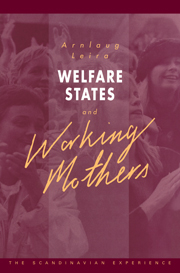Book contents
- Frontmatter
- Contents
- List of figures
- List of tables
- Preface and acknowledgements
- List of abbreviations
- 1 Introduction
- 2 Models of motherhood
- 3 Welfare states and working mothers: the Scandinavian experience
- 4 The collectivization of childcare
- 5 Mothers, markets and the state
- 6 Modes of mothering
- 7 Carer state and carer careers
- Notes
- References
- Index
3 - Welfare states and working mothers: the Scandinavian experience
Published online by Cambridge University Press: 05 December 2011
- Frontmatter
- Contents
- List of figures
- List of tables
- Preface and acknowledgements
- List of abbreviations
- 1 Introduction
- 2 Models of motherhood
- 3 Welfare states and working mothers: the Scandinavian experience
- 4 The collectivization of childcare
- 5 Mothers, markets and the state
- 6 Modes of mothering
- 7 Carer state and carer careers
- Notes
- References
- Index
Summary
The state and childcare
What is the relationship between the Scandinavian welfare states and working mothers? In welfare state literature dealing with Scandinavia it is often assumed that the welfare states in the region are developed according to a common ‘model’ (Allardt 1986; Andersen 1986; Erikson et al. 1987). The model is usually identified with an institutional approach, and with a Social Democratic tradition in government. The Social Democratic Labour parties have remained in power in Norway and Sweden throughout the greater part of the post World War II period, and predominated also in Denmark up to the 1980s. Thus, according to Esping-Andersen and Korpi (1987), a central characteristic of the Scandinavian model is that legislation is universalist and solidaristic, and that social policy is more comprehensive and institutional than in most other welfare states.
Empirically, however, ‘reproduction policies’ or, more specifically, policies concerning the provision of care for very dependent people, challenge the idea of the Scandinavian welfare states as uniformly institutional. As I have argued above (ch. 2), the economic maintenance systems of the Scandinavian welfare states (the state-guaranteed economic transfers established to replace market-based income) have a stronger institutional imprint, while the care providing systems (referring to the state-sponsored services that supplement or replace the family and private charity in caring for very dependent persons) are more residual or marginal. Still, the policies of caring might demonstrate a common Scandinavian design.
- Type
- Chapter
- Information
- Welfare States and Working MothersThe Scandinavian Experience, pp. 41 - 63Publisher: Cambridge University PressPrint publication year: 1992
- 1
- Cited by

